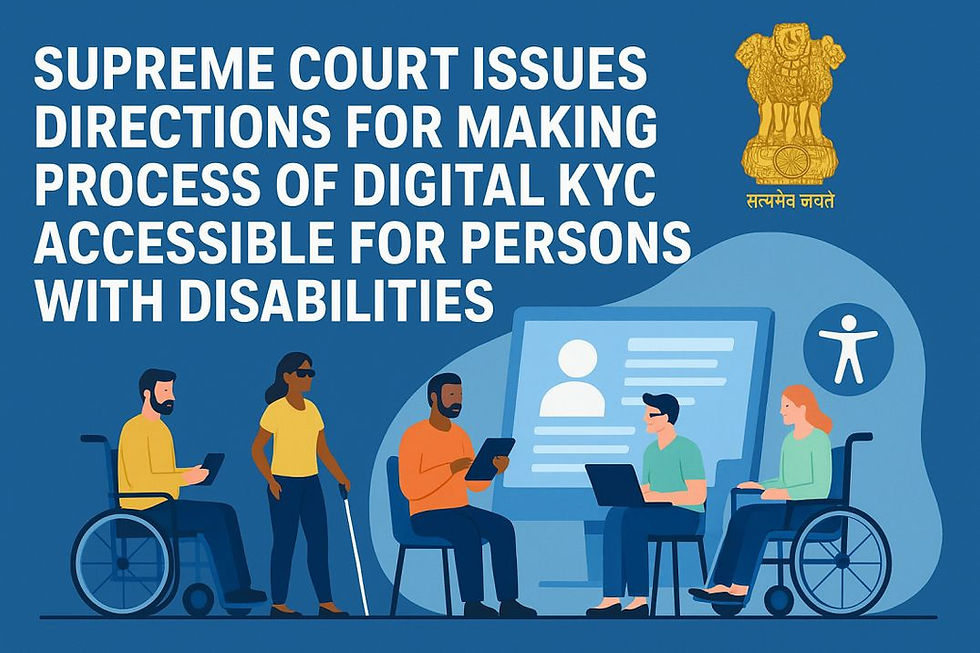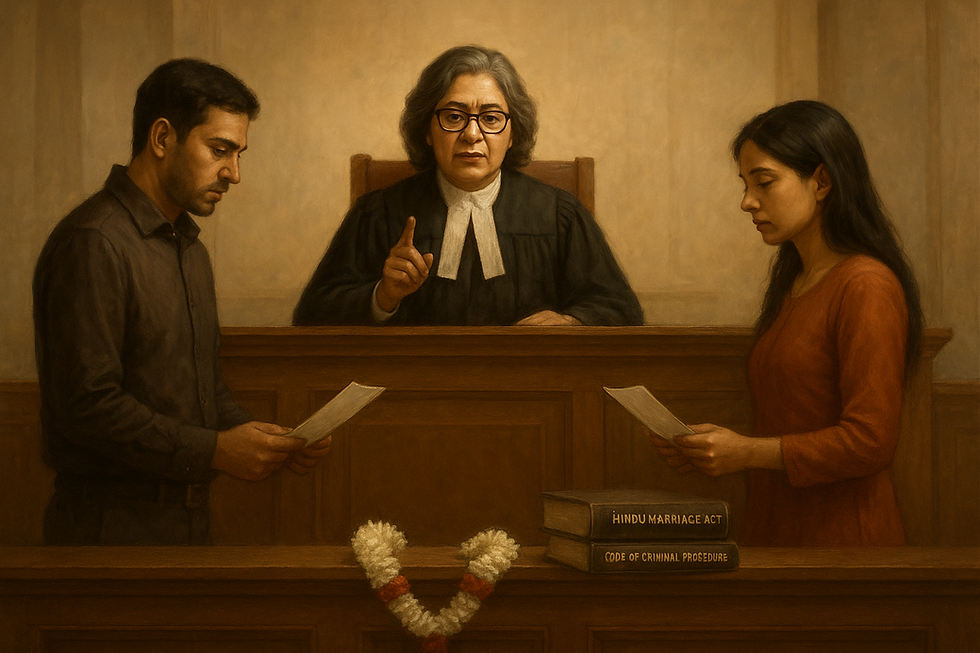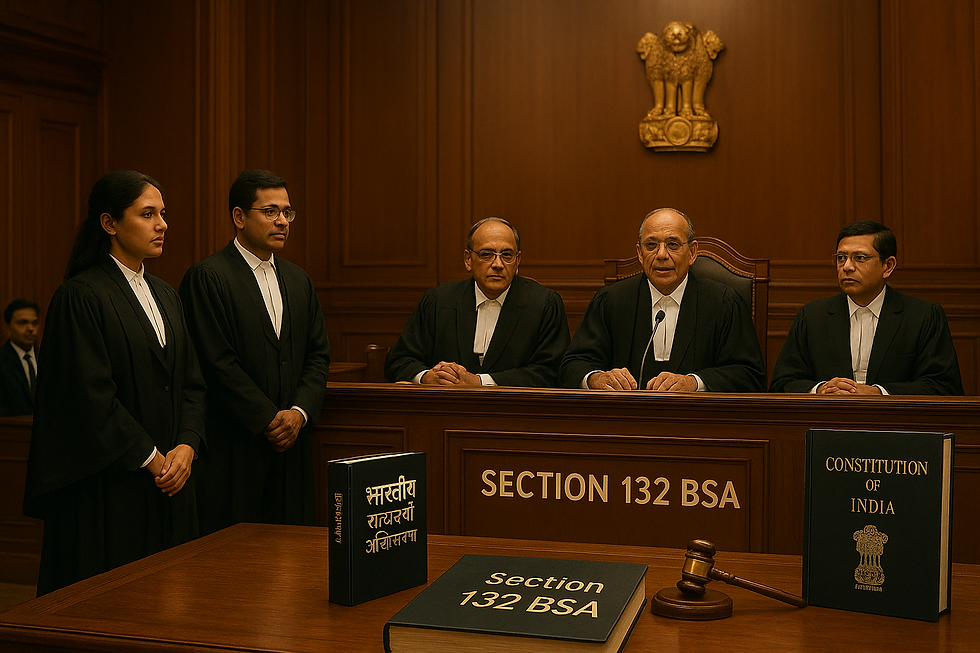Supreme Court Issues Directions For Making Process Of Digital KYC Accessible For Persons With Disabilities
- Lawttorney.ai

- May 14
- 5 min read
Case Title: Pragya Prasun & Ors. Versus Union of India & Ors. (2025)
In a landmark and comprehensive judgement delivered on April 30, 2025, the Supreme Court of India held that digital accessibility is an integral aspect of the right to life under Article 21 of the Constitution. This judgment is claimed to be a significant milestone in the recent disability rights campaign in India, especially for the visually impaired and individuals with facial disfigurement and face systemic barriers in accessing digital services.
The landmark judgment rested on two writ petitions, viz. Pragya Prasun & Ors. Versus Union of India & Ors. (W.P.(C) No. 289/2024) and Amar Jain v. Union of India & Ors. (W. P. (C) No. 49/2025), both filed by lawyers and activists for inclusive KYC practices which facilitate persons with disabilities (PwDs), especially in the case of e-KYC platforms utilized by banks and financial institutions.

Key Directions Ordered by the Court
A bench of two judges led by Justice J.B. Pardiwala and Justice R. Mahadevan ordered 20 binding directions with an eye on revamping India's digital service environment to make accessibility and inclusion the topmost. Among the most significant directions are:
Inclusive KYC Should be the Norm
The Reserve Bank of India (RBI) must now issue newer guidelines permitting alternative "liveness" detection methods in addition to the default eye-blink-test excluding individuals with specific disabilities.
Organisations need to begin to accept thumb impressions and other reachable biometric solutions for identity authentication purposes so that the KYC process becomes more inclusive and equitable.
Right to Reasonable Accommodation
All government and private reporting entities (REs) need to comply with accepted digital accessibility standards.
Each company needs to employ Digital Accessibility Nodal Officers and should be periodically audited by professionals for accessible audits.
Most importantly, PwDs need to be engaged in user testing of new digital services so that they can be tested in practical life scenarios.
Accessibility is Compulsory across Government and Private Services
All online services and government websites will be under Section 46 of the RPwD Act, 2016.
WCAG 2.1 Guidelines for Indian Government Websites (GIGW) compliance will be mandatory.
Communication and Service Delivery should be Inclusive
All digital public-facing services should provide alternative formats such as Braille, audio-described materials, and readable documents.
Functional grievance redressal mechanisms and human examination processes for rejected KYC applications should be made available to help PwDs.
Sensitization and Monitoring
All staff members employed in regulated institutions must be trained in disability inclusion and awareness.
RBI will regularly carry out public campaigns for awareness regarding inclusive KYC alternatives and enforcement monitoring.
Digital Accessibility in Financial Inclusion Beyond KYC
Even while the Court rationale for its decision primarily centered on the inclusion of KYC processes, the ultimate aim is to unlock financial opportunities for PwDs afflicted with disabilities. Access to the most basic financial services such as opening a bank account, access to credit, purchasing insurance or even mobile wallet is still lacking for PwDs since they do not have proper digital accessibility.
Online banks and fintech firms should now consider accessibility a regulatory requirement, not an add-on. Navigation should be enabled through voice navigation, large text interface, and keyboard navigation. For individuals with cognitive disabilities, ease of design and visual assistance are absolute requirements. These aids have the responsibility of upholding the disability rights intact in financial environments as part of the right to dignity and life.
If you want a genuinely inclusive digital economy, you need to do more than one-time verification. It must make all digital financial transactions accessible, whether it is paying autopay, updating a password, or even glancing at a statement. As a form of financial technology, inclusion is not merely a compliance issue against the law; it is an ethical demand.
Bridging the Rural-Disability Digital Divide
The Supreme Court has also addressed the reality of a broadened digital divide that impacts the rural masses, and not merely the disability population. For such individuals at the intersection, the PwDs residing in backward or remote areas, the impediments are further added. The poor connectivity of internet services, absence of localized content, and even the low digital literacy are compounded with the non-availability of sophisticated systems.
This mandate calls for a policy change in the form of saying cyber access needs to be designed with sensitivity to geographical variations. Government portals and mobile financial applications are mandated to provide regional language interfaces along with offline enablement functionalities. Further, any available KYC solution also has to accommodate limited device availability or simple mobile phones.
Bridging this gap of digital divide is not just a technological imperative but also a constitutional requirement. As the Court emphasized, providing equal access to the digital space is now a direct application of the right to life under Article 21 and necessary for the realization of substantive equality under Articles 14 and 15.
A Game-Changer for Disability Rights and Digital Equality
This ruling unmistakably states that access to online services is not a privilege but a constitutional right, especially of the disabled, who have systematically been excluded from India's information revolution. Not only has the Court answered the how (means and norms), but also the why - the essential need to treat individuals with disabilities with respect as fellow citizens deserving of convenience and autonomy.
From e-governance and banking to healthcare and education, much hangs in the balance. It is a categorical imperative: access is not a choice - it is a mandate.
Next-Steps: From Judgment to Justice
To bring this historic judgment to life:
Disability rights campaigners and civil society organizations must monitor closely as implementation occurs.
Regulators, tech developers, and PwD communities must join forces and turn legal obligations into realities.
The court directive is in line with India's obligations to the UN Convention on the Rights of Persons with Disabilities (UNCRPD) and aligns with the Accessible India Campaign mission.
But the journey from here onwards must be navigated with caution. Recognition through legislation is merely the beginning because actual inclusion must be brought about through concerted effort to change systems, technology, and mindset.
Conclusion
The Supreme Court judgment is a leap of giant proportions towards making digital accessibility affordable to all, particularly the disabled. By identifying it as a part of the right to life, the Court enriched constitutional jurisprudence but also categorically addressed the lived experience of PwDs. The real test, however, is the successful implementation of these directions, which depends on the collective effort of the government, private sector, civil society, and the PwDs community.
Call to Action:
We must know in the future what is required:
Government agencies expedite the creation and application of accessibility standards.
Private organizations value accessibility highly in their digital offerings.
Schools integrate accessibility education into their curricula.
Civil society organizations keep pushing for the rights of PwDs and tracking implementation of accessibility standards.
It is only by coming together that we can fulfill the vision of an inclusive digital India for everyone.
Empower Your Legal Practice with AI
Are you a legal professional? Stay ahead with our innovative Lawttorney.AI tool. Streamline your legal processes, enhance productivity, and gain a competitive edge. Experience the future of legal technology—try our free Webinar session today!




Comments